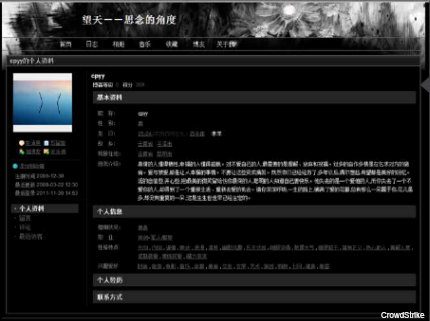Cyber conflict escalates: Second Chinese PLA hacking group accused
CrowdStrike releases a report implicating a Chinese military group in cyber espionage focusing on the satellite and aerospace industries.

Photo of a satellite dish in Shanghai, from a suspected PLA hacker's album.
A new industry report has linked cyberattacks on U.S. and European defense, satellite and aerospace industries to a second Chinese People’s Liberation Army hacking unit.
Researchers at CrowdStrike, a California-based security company, released the report June 9, attributing a series of cyberattacks to the PLA’s Unit 61486. The unit, according to the report, is headquartered in Shanghai and is a part of the 12th Bureau of the PLA’s 3rd General Staff Department, and specifically focuses attacks on foreign satellite, aerospace and communications industries to support China’s space surveillance network. CrowdStrike refers to the group as Putter Panda, due to the group’s tendency to attack golf-playing conference attendees.
The 3rd GSD is often referred to as China’s National Security Agency, and is responsible for handling signals intelligence for the PLA. In the PLA, units above the platoon level are issued Military Unit Cover Designators when describing units – true unit designators are rarely used in public and in press releases.
CrowdStrike’s investigation found evidence of specific actors associated with Unit 61486’s operations, as well as several indicators that link these individuals to the PLA’s Shanghai operations. The report specifically identifies one individual named Chen Ping, known by his online moniker as cpyy, linking him to the PLA and the primary location of the unit.

The personal blog of a suspected PLA hacker known as ccpy.
The group utilized emails containing PDFs and word documents related to space technology conferences that would inject remote access tool malware into victims’ systems when opened, ultimately allowing the hackers to enter secured networks. For instance, one email contained an invitation to a yoga studio in Toulouse, France, for conference attendees. Documents containing job opportunities and event information were also used.
The report also found evidence that Unit 61486 sometimes worked with Unit 61386, codenamed Comment Panda. Unit 61386 was also publically revealed by the security firm Mandiant in a February 2013 report that marked the first time the Chinese military was overtly accused of having links to an advanced persistent threat.
The CrowdStrike report comes in the wake of the U.S. government’s indictment of five members of another unit — 61398 — for acts of cyber espionage, the first time that charges were ever filed against a state actor for cybercrimes.
“We believe that organizations, be they governments or corporations, global or domestic, must keep up the pressure and hold China accountable until lasting change is achieved,” the report states. “Not only did the U.S. Government offer in its criminal indictment the foundation of evidence designed to prove China’s culpability in electronic espionage, but also illustrated that the charges are only the tip of a very large iceberg.”
The “iceberg” is indeed likely to be huge, according to the assessment of China’s military strategy in the Pentagon’s annual report last week to Congress regarding Chinese military and security developments.
In preparing for potential conflict in the Taiwan Strait and the East and South China seas, the Chinese military has recognized the need to improve information control capabilities, with the understanding that any U.S. intervention would rely heavily upon its space and cyber network infrastructure, the Pentagon said.
“Almost all of the PLA’s 2013 exercises focused on operating in ‘informationized’ conditions by emphasizing system-of-systems operations, a concept that can be viewed as the Chinese corollary to U.S. network-centric warfare,” according to the report. These conditions include developing systems with information capabilities integrated into systems while also degrading an adversary’s ability to use their own networks through electronic warfare and computer network operations.
Cyber espionage also remains as one of China’s avenues for military modernization, according DOD.
“In the case of key national security technologies, controlled equipment, and other materials not readily obtainable through commercial means or academia, China has used its intelligence services and other illicit approaches to collect sensitive U.S. information and export-controlled technology in violation of U.S. laws and export controls,” the report says.
Putter Panda’s foray into attacking satellite and aerospace companies thus represents threats on several different levels – cyber espionage could be used to steal important intellectual property and shorten development timetables, as well as find network and satellite weaknesses to be exploited in case of conflict.
These cyber security threats are far-reaching and pervasive, CrowdStrike said. Through widespread espionage campaigns, Chinese threat actors are targeting companies and governments in every part of the globe, according to the report.